23 Oct 2017
Harriet Coates discusses the use of alpha₂-adrenoceptor agonists in equines and some of the side effects that can occur.

Horses and ponies are frequently sedated to enable procedures that may be frightening or painful to be performed safely for the horse, vet and handler. A sedative is a drug producing mental calming through sleepiness, while a tranquiliser achieves mental calming through reduced anxiety and awareness, and decreased locomotor activity1. Both are often referred to as sedatives. They are usually administered by IV injection and, less often, intramuscularly. Some sedatives also provide analgesia, which may be sufficient for the procedure, while at other times additional local anaesthetic may be required.
Oral sedatives may be prescribed for management changes/events where the vet may not be present, such as loading, box rest or farriery. The classes of drugs most commonly used for sedation are alpha2-adrenoceptor agonists, opioids, phenothiazines and benzodiazepines. Sedated horses can wake suddenly, so must always be respected.
In situations where sedation is used to prevent an unwanted behaviour, another approach may be available, albeit one involving significant time and commitment, that can lead to improved horse welfare and personnel safety. Growing appreciation of the science of ethology, horse behaviour and learning theory exists. Training, led by an understanding of the motivation for the unwanted behaviour, may lead to less or no sedation being required.
Alpha2-adrenoceptor agonists have a number of effects on the CNS. Action within the locus coeruleus in the brainstem produces sedation with head lowering, ptosis, ataxia and lower lip drooping (Figures 1 and 2). Anxiolysis is due to action in the reticular activating system. Analgesia and muscle relaxation also occur2.
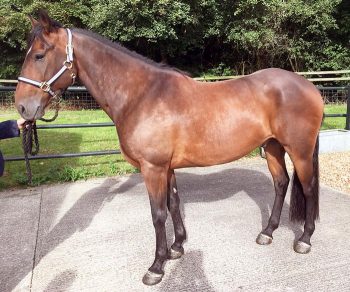
Three agonists, with differing selectivities, are commonly used in equine practice. Xylazine is the shortest acting; romifidine gives less ataxia, muscle relaxation and possibly less analgesia than detomidine for similar sedation3; and detomidine is available as an oral gel, as well as an injectable.
Alpha2-adrenoceptor agonists are commonly combined with opioids, synergistically improving quality and reliability of sedation2, and, of these, the agonist-antagonist butorphanol is the most widely used as it has marketing authorisation for horses4. As opioids can cause excitement when given intravenously, it is recommended (included in some data sheet advice) to give the opioid a few minutes after the α2-adrenoceptor agonist, although they are often given together. Forward movement, or muzzle twitching or shaking, may occur.
The phenothiazine acepromazine (ACP) is available as an injection and oral gel. It has antidopaminergic actions in the CNS and depresses the reticular activating system5, leading to decreased anxiety, although, very rarely, paradoxical excitation and aggression is seen.
Benzodiazepines (diazepam and midazolam) are unlicensed, but commonly used in foals for sedation6. They lead to enhancement of inhibitory neurotransmitters, with resulting sleepiness due to depression of activity in the reticular activating system, and also cause postural muscle weakness.
When choosing a sedative, consider:
For the α2-adrenoceptor agonists, equivalent doses are:
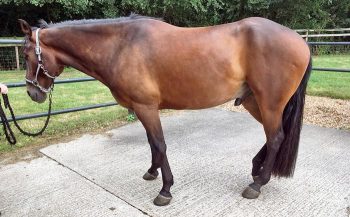
When combined with butorphanol at 0.01mg/kg to 0.02mg/kg IV (10mg/ml, 0.1ml to 0.2ml per 100kg), the dose of α2-adrenoceptor agonist is usually halved.
Sedation is less predictable if the horse is excited, stressed or in pain. Sedation is dose-dependent to a ceiling, after which duration increases, but not degree1. Analgesia is thought to last a third to half the duration of sedation. When given IV, the peak plasma concentration is greater, but, when given IM, slower elimination and longer time of maximal plasma concentration7 occurs, so a longer duration of sedation. After IM injection, the time of first detection in plasma is variable6 and analgesia is shorter lived8.
Following sedation, horses should not be fed until they are fully awake, as an increased risk of choke exists. For advising owners when the horse may be ridden, guidelines are 8 hours for xylazine, 24 hours for detomidine and 48 hours for romifidine1, but this will vary with the dose given and horse.
Several side effects occur with α2-agonists. Complicated cardiovascular effects lead to bradycardia and an increase in arrhythmias (predominantly atrioventricular or sinoatrial block), and an initial increase in blood pressure followed by a decrease3.
Therefore, it is advised a clinical examination is performed, including cardiac auscultation, prior to administration or prescription of sedatives. Respiratory depression occurs, diuresis occurs due to decreases in antidiuretic hormone and relaxation of the urethral sphincter tone may lead to more frequent urination. There is also reduced gut motility and sweating occurs, which can be a nuisance when sedating for clipping (Figure 3).
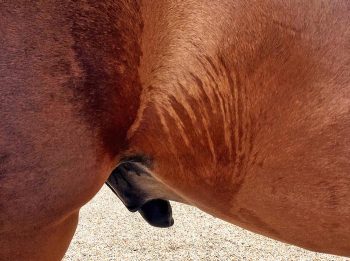
Two precautions are not to administer injectable trimethoprim/sulfamethoxazole after sedation with α2-adrenoceptor agonists, as potentially fatal cardiac arrhythmias may occur, and not to administer xylazine to epileptic horses, nor as sedation before euthanasia with secobarbital and cinchocaine1.
In situations of adverse cardiovascular effects or accidental overdose, reversal is possible with α2-adrenoceptor antagonists. These also have undesirable side effects, including excitement, muscle trembling and triggered inappropriate stress responses, and horses demonstrate a variable response9. Atipamezole (unlicensed in horses) can be given slowly IV to 0.05mg/kg.
ACP has wide dosage rates as response is inconsistent – 0.01mg/kg to 0.05mg/kg IV, 0.03mg/kg to 0.1mg/kg IM and 0.1mg/kg to 0.25mg/kg by mouth1. ACP is a peripheral α2-adrenoceptor antagonist causing vasodilation and hypotension. It is contraindicated in horses with colic or post-haemorrhage, and used extremely cautiously in hypovolaemic or excited horses, as many get syncopal episodes.
Cardiovascular effects last longer than sedative effects, and increasing the dose usually prolongs cardiovascular effects without increasing sedation.
ACP causes muscle relaxation, including retractor penis muscle relaxation. This is useful if examination of the penis is required, and retraction should occur within a few hours. However, penile paralysis may occur and prolonged exposure results in trauma, swelling and risk of paraphimosis. ACP can also cause priapism and lead to impotence, so avoid use in stallions. If essential then use a low dose and keep away from mares for 48 hours1. Avoid in horses with moderate to severe liver disease, as the primary organ of metabolism is the liver5.
Many horses are difficult to inject, and different situations require different approaches. Physical restraint, such as a neck or nose twitch, may enable injection. Where a horse can be injected, but will not stand, a preloaded short fluid line can be attached to a (butterfly) needle to enable remote sedation.
If the horse will allow oral medication, oromucosal gel can be administered, but must go sublingually to be effective, or if the head cannot be handled try putting detomidine (60µg/kg) in sugar cubes or molasses, so it can be absorbed mucosally and not just swallowed (off licence and variable efficacy). Oral ACP gels can be given directly or mixed with food, giving mild sedation that may be sufficient to then enable injection. Leave the horse quiet for 30 minutes after oral sedation.
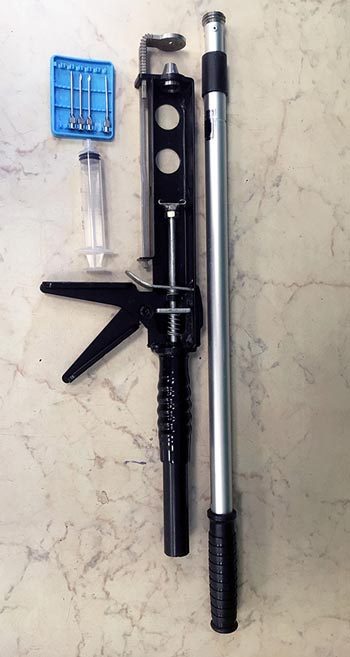
For horses known to be difficult to inject, rather than restraining the horse, increasing interest exists in retraining. Although details are beyond the scope of this article, the BEVA webinar “Practical equine behaviour; how to transform your needle-shy neddies”, by Gemma Pearson, provides an excellent introduction, covering how horses learn and how vets can adapt techniques to make restraint, examination and treatment easier and safer.
For an emergency situation with a frightened (or feral) horse, if you are able to inject intramuscularly administer a high dose of detomidine (up to 60µg/kg, 3ml/500kg) or a combination of detomidine 0.2ml/100kg, butorphanol 0.5ml/100kg and ACP 0.3ml/100kg 1 (all 10mg/ml). With horses in this state a high initial dose is necessary, as top-up doses are less effective. A pole syringe can be very useful (Figure 4). On rare occasions, horses may require the sedative to be given via a dart rifle.
Neonatal (younger than one month old) and juvenile (one to three months old) foals are physiologically different from mature horses. In neonates, cardiac output is primarily rate-dependent, so α2-adrenoceptor agonist-induced bradycardia has a significant impact on cardiac output. Foals are also more susceptible than adults to hypothermia and hypoxaemia. Body position influences oxygenation being higher when standing or in sternal than laterally recumbent6. The minimum sedation should be used and the foal carefully monitored.
IV diazepam (0.01mg/kg to 0.1mg/kg slow IV) causes recumbency and sedation sufficient for radiography and minor procedures. Within a few minutes, foals become limp and can be gently lowered to the ground. If analgesia is required locally, anaesthesia can be used or butorphanol (0.1mg/kg to 0.2mg/kg IV or IM) added6. Diazepam reacts with the plastic in syringes, becoming less active, so draw it up just before use and dispose of any unused drug.
Low-dose xylazine (0.2mg/kg to 0.3mg/kg IV) may provide adequate sedation for a short period. Respiratory rhythm may be markedly disrupted, so do not give to foals with respiratory disease. Detomidine is less desirable than xylazine in young foals as it has a higher incidence of dysrhythmias6.
Depending on the procedure being performed on the foal, the mare may also need sedating. Sedation for pregnant mares is difficult, as safety during organogenesis may not have been established in horses, and adverse effects occur on the uterine muscles, and placental and foetal blood flow. Data sheet information can vary between products containing the same active ingredient.
Xylazine and romifidine (+/- butorphanol) can be used throughout most of the gestation, but are contraindicated during the final month. If sedation is necessary then discuss with the owners about going against data sheet recommendations and record verbal consent. Detomidine with butorphanol should not be used in pregnancy. Sedation for prolonged procedures is useful to allow many diagnostic and minor surgical procedures to be done standing. Rather than repeated boluses, continuous infusion sedation aims to maintain an even plane of sedation. The disadvantages are time to set up and expense if a whole bag is prepared for a relatively short procedure.
A number of published protocols are available for infusions; for example, detomidine infusion10 (Figure 5):
Good indicators of depth are degrees of ptosis and reaction to environmental stimuli (the latter can be helped with cotton wool in the ears and a blindfold/blinkers). As detomidine takes several minutes to achieve full action, it is necessary to pre-emptively adjust the drip rate.
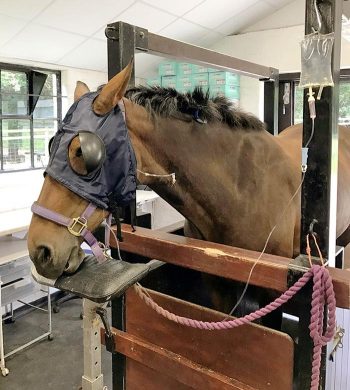
An analgesic dose of butorphanol 0.1mg/kg can be given once the catheter is placed, which can improve sedation quality and reduce the amount of additional α2-adrenoceptor agonist. However, forward movement and twitching can occur, so, depending on the procedure, local anaesthesia may be a more appropriate analgesic. Certain precautions are sensible to take with α2-adrenoceptor agonist infusions. As they are diuretic, crystalloid fluid replacement should be administered4. The increased diuresis, coupled with reduced gut motility, may increase risk of colic, so pre-sedation and post-sedation feeding should be adjusted and horses monitored4. Lastly, the head should be supported to reduce nasal mucosal swelling11.
Sedation for clipping, dentistry and farriery is often requested. Problems can arise if an injury occurs to the horse caused by the person whose work the sedation is facilitating, or an injury caused by the sedated horse to itself or personnel. The latter has constituted some of the larger claims handled by the Veterinary Defence Society. Advice notes on this matter can be found at www.thevds.co.uk
To minimise risk, the vet should speak with the technician about the planned procedure to determine suitable sedation. The client should be warned of risks associated with sedation; that horses can still behave unpredictably, react to stimuli, barge and kick accurately, and be advised it is preferable for the vet to remain throughout the required sedation. It should be confirmed the vet is only responsible for the sedation and not work carried out under sedation, and when sedating for dentistry the legal limitations of work done by equine dental technicians understood. If disputes occur, it is helpful to have consent recorded in clinical notes.
Calmers are not sedatives, but supplements designed to alter a horse’s behaviour and reduce stress reactions. Great disparity exists in effect of different calmers on different horses, but, on occasion, may be sufficient to warrant mild sedation unnecessary. Many calmers contain magnesium and/or l-tryptophan. Tryptophan is an essential amino acid and precursor of the neurotransmitter serotonin, increased brain levels of which have been associated with increased sleepiness and reduced fearfulness in some species12.
Studies in horses have been mixed, ranging from fewer behavioural signs of stress in a challenging situation13 to no calming effect observed14. Magnesium is involved in the regulation of the CNS and neuromuscular transmission, and stressors may increase use. Evidence has been lacking, but a study reported oral magnesium supplementation changing an objective measure of behaviour15.